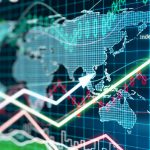
The horrendous stock market performance last week has hopefully put to rest any notions that the Dow Jones will continue pushing upward to set new highs. A market that is reliant on easy money and investor euphoria for its continued growth is a market that is destined to crash, and to crash hard. The economy is under attack on three different fronts, making it more and more likely that 2018 will be a rough year for stock markets.
The Growing Bubble
Assets across multiple sectors are at historically high valuations. Stocks were almost the last asset class to rise, with the past two years having seen a meteoric rise, largely on the backs of the FANG stocks. But bubbles permeate the economy. House prices remain high, commercial real estate is in a bubble, bonds have been in a multi-decade bubble, and numerous other assets remain artificially overvalued. Whenever you see a headline that tells you that some statistic has reached the highest levels since before the financial crisis, you can almost assuredly believe that it’s an indicator of a bubble.
Rising Interest Rates
The Federal Reserve raised its target federal funds rate again last week, as was expected. The rate is now set at 1.50-1.75%, which is still historically low. Yet even these low rates are enough to give markets the jitters. All other interest rates in the economy are rising too, including mortgage rates. As interest rates continue to rise, debtors will find it more and more difficult to pay off their debts, which could result in a repeat of the 2008 crisis.
Trade War
While President Trump came into office talking a tough game on trade, no one thought he would actually follow through on an aggressive regime of tariffs quite so soon. Now that it has become abundantly clear that he intends to use tariffs as a weapon to force other countries to do what he wants, markets are justifiably fearful of a trade war.
No one “wins” a trade war. Trump’s tariffs remind many people of the disastrous consequences of the Smoot-Hawley Tariff of 1930. That protectionist tariff law spurred a cycle of retaliatory tariffs worldwide, leading to a plummeting of world trade and a worsening of the Great Depression.
History Repeats Itself
Here we are in 2018, about to repeat the same mistakes of the 1920s and 1930s. In the 1920s, economic growth was spurred by the Federal Reserve’s loose monetary policy. Because production was increasing, the increased inflation didn’t show up as rising prices, so most people didn’t realize there was a bubble until it burst. The post-2008 recovery has operated in much the same manner, with easy money forcing up prices that would otherwise have declined.
And now with a possible trade war on the way, it’s like the 1930s all over again. Most investors are still in a 1980s and 1990s mentality, believing that stock markets will continue to rise 6-10 percent on average every year. The idea that we could be in for another Great Depression, with 25 years of no stock market growth, doesn’t appear on most people’s radar screens. Yet that is where we could find ourselves very soon.
That’s why the case for gold has never been better. In a best-case scenario, stocks and bonds will crash and investors will lose out big. In a worst-case scenario, the dollar itself will crash and all dollar-denominated assets will see major declines. But investors who protect themselves by buying gold will be able to save themselves from the worst. Gold is the ultimate hedge against inflationary monetary policy and financial calamity. So if you want to protect your retirement savings, you really ought to look into buying gold, before markets fall any further.
The post Continued Stock Market Upheaval Makes the Case for Gold appeared first on Goldco.
No comments:
Post a Comment